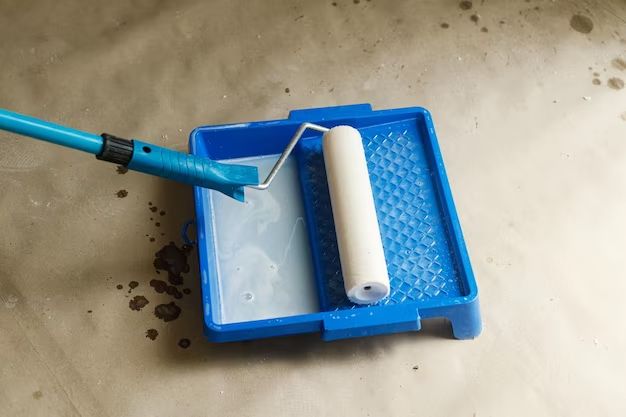Page Contents
Quick Answer
Yes, it is highly recommended to prime garage walls before painting them. Priming creates a uniform surface for the paint to adhere to, seals the walls to prevent bleed-through of stains, and improves paint coverage and durability. Priming is an essential preparatory step that helps ensure a professional, long-lasting paint job.
Why Priming is Important
Priming garage walls serves several important purposes:
Creates a Uniform Surface
Garage walls are often covered in dirt, grease, handprints, and imperfections. Priming evens out the porosity differences in the wall and creates a uniform surface for the paint to stick to. This allows the topcoat of paint to go on smoothly and evenly.
Seals Against Stains
Garages are prone to oil stains, mud splatters, and other stubborn marks. Priming seals the walls and prevents these stains from bleeding through the paint. Without a primer, stains can discolor the paint coat and show through over time.
Improves Paint Adhesion
Paint adheres much better to primed surfaces than bare drywall or concrete. Priming creates a tacky, grippy layer that the paint can grab onto for maximum bonding strength and coverage. This helps prevent peeling or delamination down the road.
Enhances Paint Coverage
Primer tints the walls to match the topcoat of paint and helps hide imperfections. This allows the paint to cover fully in fewer coats, saving time and money on paint. Priming leads to a more even, professional looking paint job.
When to Use Oil-Based vs. Latex Primer
When priming garage walls before painting, you have a choice between oil-based and latex water-based primers. Here are the factors to consider:
Oil-Based Primer
– Best for heavily stained or slick surfaces like bare metal or concrete
– Provides superior sealing and stain-blocking
– Has a stronger odor and requires mineral spirits for cleanup
– Takes longer to dry compared to latex primers
Latex Primer
– Works well for drywall, plaster, and wood surfaces
– Lower odor, cleans up with soap and water
– Dries faster than oil-based
– Not as effective for heavy stains or bare metal
So for new or lightly stained drywall, a latex primer is fine. For covering heavy grease stains, oil drips, or painting over bare concrete, an oil-based primer is the best choice.
How to Prepare Garage Walls for Priming
Proper prep work is crucial prior to priming and painting the garage walls:
1. Clean the Walls
Sweep away any loose dirt and debris. Use a general degreaser to clean away any oil spots or built-up grime. For concrete walls, use a concrete degreaser and etch the surface with an acidic etching solution. Rinse thoroughly.
2. Repair Cracks and Holes
Fill any cracks, holes, or imperfections with spackle or drywall joint compound. Allow repairs to dry fully then sand smooth.
3. Remove Loose Paint
If the walls were previously painted, scrape away any cracked or peeling paint. Feather the edges smooth with sandpaper.
4. Sand Glossy Surfaces
For slick garage walls painted with gloss enamel, lightly sand to dull the sheen and create a surface the primer can grab.
5. Apply Drywall Sealer
Seal raw drywall with a drywall sealer to prevent excessive absorption of primer.
Once these steps are completed, the walls will be ready to prime.
How to Apply Primer
When priming garage walls, follow these best practices:
Select the Right Primer
Choose either latex or oil-based primer as previously discussed. For stained walls, use a stain-blocking primer formulated to lock in stains.
Prep the Primer
For oil-based primers, stir the primer thoroughly before use. For latex primers, simply shake the can vigorously. Pour some primer into a roller tray.
Use a Paint Roller
Apply primer with a high-quality roller cover with a 1/4″ to 3/8” nap. This creates an even coat. Use an angled trim brush for the corners and edges.
Apply Along the Natural Light Source
Work in sections rolling primer on in the same direction as the lighting source, typically vertically. This avoids lap marks.
Work from the Top Down
For the first coat, apply the primer from the top of the wall down to avoid drips. Use an extension pole for high ceilings.
Apply Two Coats
Let the first coat dry fully, then apply a second coat to ensure complete, uniform coverage. Two full coats are recommended.
Check Coverage
Verify the primer has fully covered the walls without any thin or missed spots. Add a third coat if needed.
How Long to Let Primer Dry
Allow ample drying time for the primer before painting:
– Oil-based primer: 24 hours
– Latex primer: 2-4 hours
The primer should be completely dry to the touch before painting. Cool temperatures or high humidity can extend the drying time. Fans can help accelerate drying.
Tips for Priming Garage Walls
Follow these tips for a flawless priming job:
– Wear protective eyewear and gloves to avoid primer exposure
– Work in a well-ventilated area to minimize fumes
– Use drop cloths or tarps to protect the floor from drips and spills
– For bare concrete, use a concrete bonding primer to improve adhesion
– Spot prime any remaining stains after the first full coat dries
– Use painter’s tape for clean edges along trim and ceilings
Conclusion
Priming before painting garage walls is a crucial step to ensure the paint bonds tightly and lasts longer without stains bleeding through. Oil and latex-based primers both work well, with oil being ideal for heavy stains and concrete. Prep the walls thoroughly, apply two full coats of primer, and let dry fully before painting for a professional quality, long-lasting finish.

